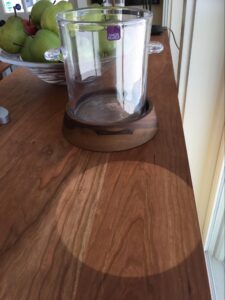Solid Wood Furniture Care
General Use
A well-made piece of furniture can last for hundreds of years. Wood is very strong, and with proper care your piece will be a family heirloom that can be passed down from generation to generation. You won’t find anything from Ikea on Antiques Roadshow.
Temperature
Wood is organic and reacts to its environment by expanding and contracting along its width. A good craftsman takes this movement into account when building the piece so that joints don’t separate over time. For your part as the owner, you should keep the indoor humidity around 30-45% and room temperature in the 60-80 degree range all year long.
Ultraviolet Light
Ultraviolet light from the sun and florescent fixtures can cause chemical changes in the wood and/or finish.
Most woods will darken with age and exposure to oxygen and UV light. This natural process enhances the look of the piece. For example, a newly made cherry end table starts out a light pink and darkens over time to a rich reddish-brown hue with a lustrous patina.
Keep this in mind as objects placed on the surface of your furniture can affect this process, leaving behind undesirable results that may be impossible to fix.

Cleaning
Stay away from cleaners that contain alcohol and bleach, which can stain wood and strip the finish.
Use a damp rag and mild soap to clean up spills. Avoid letting and liquid remain on the surface – be sure to wipe dry.
Maintenance
Regular dusting is all that’s needed to keep your furniture looking its best. Furniture polishes like Pledge and Murphy’s Oil are okay to use in moderation. Using too much can leave behind a filmy buildup.
For heavily used pieces like a dining room table, it helps to protect your investment with a tablecloth and placemats. Be sure to use natural cloth, as plastic materials can leech into the wood and cause discoloration.
Place felt pads on objects you put on any wood surface to avoid scratching the finish.
Damage
Accidents happen. Table legs can easily be damaged by a vacuum cleaner or a family pet. Sweat from a cold glass or heat from a hot beverage can penetrate the finish and leave a white ring on your tabletop. Some common household items can repair mild damage:
Stains
An ink or kool-aid spill can be difficult to remove, but it’s not impossible. Mix baking soda and water and pour the mix over the stain, then wipe it off with a damp cloth. If you don’t have baking soda, sometimes dish washing liquid will do the trick.
For rings, try blowing a hair dryer on the affected area. If that doesn’t work, rub car wax, petroleum jelly or toothpaste on the area, and then wipe away with a damp cloth.
Nicks, Scratches and Dents
For small scratches that aren’t too deep, all you need is a matching color. You can mask the scratch with a marker, crayon, shoe polish or even coffee grounds.
To repair small dents, place a damp cloth over the damaged area and use a hot iron to steam out the dent. The heat and moisture decompresses the wood fibers and restores the surface to new condition. Check out this video for more information.
Major Damage
If the unthinkable happens, all is not lost. Most solid wood furniture can be repaired and refinished. Sometimes, the repair is completely invisible and no one would ever know! But even if that’s not the case, repairs add character and tell the story of the piece.
Furniture is meant to be used, so don’t despair if your cherished heirloom has seen better days and needs some work. We will always offer repair service on Iron & Branch pieces, and will take on other repair and restoration work on a case-by-case basis.